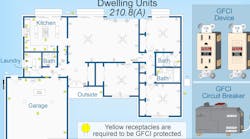Before you install these systems, you better understand OSHA requirements.
So you want to install a custom-made piece of equipment. But you don't know if you should - or if it's legal. Let's look at what requirements your equipment must meet.
OSHA requires that all available electrical equipment be listed and labeled by a nationally recognized testing laboratory (NRTL). If such electrical equipment is not listed, labeled, and available, you can install custom-made equipment under certain conditions. However, the equipment must comply with requirements set forth by the assistant secretary of labor. It must meet the rules in OSHA 1910.399.
The requirements in OSHA 1910.302 through 1910.308 pertain to electrical equipment installed before and after certain dates listed in Subpart S of the 1910 Standard. Any piece of electrical equipment that was designed, installed, and inspected after March 15, 1972 must comply with these sections' provisions. And any major replacement, modification, repair, or rehabilitation performed before or after March 15, 1972 on such systems must comply with these requirements.
Major replacements, modifications, or rehabilitation include work similar to the tasks involved in constructing a new building or facility, adding a wing to a structure, or renovating an entire floor.
Note that certain provisions in OSHA 1910.302 through 1910.308 apply only to electrical systems and equipment installed after April 16, 1981 and are not retroactive. These nonretroactive requirements (and the electrical installations and equipment they apply to) are listed in 1910.302(b). To better understand OSHA's approval of equipment, review OSHA 1910.7, 1910.303(a), and 1910.399.
The NEC, OSHA, and NFPA 70E do not include detailed requirements for wiring inside electrical equipment. You can usually find information pertaining to the internal wiring of equipment in individual standards, which contain special requirements for installing the equipment concerned. It is not the intent of the NEC and OSHA to take away the authority of inspectors to examine and approve equipment. However, the NEC and NFPA 70E indicate that an independent, qualified testing laboratory usually investigates and approves the internal construction of equipment. OSHA, on the other hand, requires a NRTL to certify electrical equipment, per 1910.303(a), Subpart S of the standard.
Note that, after installation, the authority having jurisdiction (AHJ) must approve the custom-made equipment. The AHJ, in turn, will most likely require that a UL field evaluation approve the equipment.
Custom-made equipment should be designed and built based on the provisions listed in the NEC, NFPA 79, UL 508, and - if necessary - one or more of the C series published by ANSI (this depends on the equipment involved). It is the customer's responsibility to specify to the manufacturer the function the equipment will perform.
When installed, conductors and equipment must be approved and comply with the NEC. That is, they must be acceptable to the AHJ, per Art. 100. In regard to the acceptability of components, wiring methods, and equipment, the requirements of OSHA 1910.303(a) and NEC Sec. 110-2 are nearly identical. The AHJ will usually require third-party certification of all equipment. In such an instance, a qualified testing laboratory will evaluate and verify that the equipment will do what it is designed to do without endangering the user. The problem with accepting equipment not certified by a third party is that the AHJ becomes solely responsible for the safety of the equipment.
National Recognized Test Laboratories (NRTL) and certifying organizations include: Underwriters Laboratories, Inc. (UL); Factory Mutual Engineering Corp. (FM); Electrical Testing Laboratories (ETL); MET Testing Company, Inc.; and Canadian Standards Association (CSA). Note: These are just a few of the testing laboratories approved by OSHA.
OSHA demands third-party certification for any and all electrical equipment designed and installed in industrial locations. Custom-made equipment (one of a kind) is acceptable where the needed equipment is not available for purchase and is not listed and labeled by an NRTL.
It is the sole responsibility of personnel who have been designated to accept, install, and maintain electrical equipment to do so in a safe and reliable manner. Such personnel do not have the authority to "wire in" and modify electrical elements that do not comply with the NEC, OSHA, and the various testing laboratories' related standards. This rule also applies to custom-made equipment. Before purchasing and installing custom-made equipment, you should check with the local AHJ and OSHA inspectors to get their point of view on requirements for approving such equipment.


